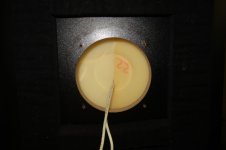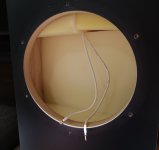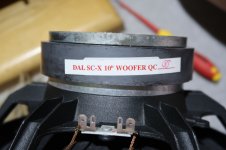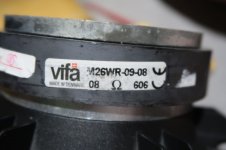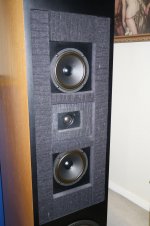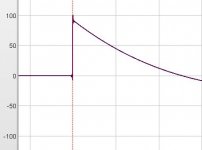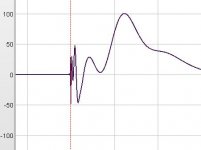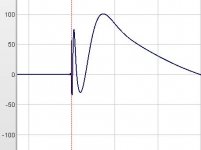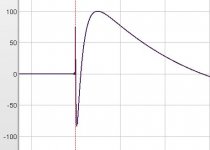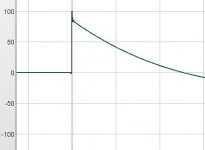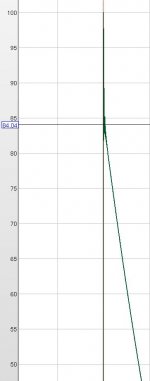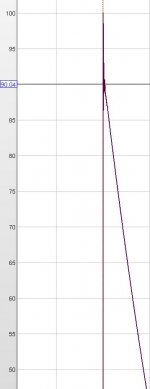The PL13 make a brilliant midrange - very flat and well behaved from < 100Hz to well above any sensible crossover frequency to a D27.
I built a pair of monitor speakers using these along with a sub.
The wide region of crossover between the PL17 and D27 bade crossover design a relatively simple process. Measuring the phase centre of the drivers and building an enclosure to ensure these were aligned was fiddly, but once done the crossover "just worked". (For what it's worth I used sloped front on the enclosure to achieve alignment as I was not using an MTM).
The only comment / complaint I would have is that their sensitivity is modest. Given the "stable" of other speakers these sit amongst in my collection, there is an efficiency (and ultimately SPL limit) gap.
If you don't confuse your listening room with a live music venue, then they do exceptionally well.
I built a pair of monitor speakers using these along with a sub.
The wide region of crossover between the PL17 and D27 bade crossover design a relatively simple process. Measuring the phase centre of the drivers and building an enclosure to ensure these were aligned was fiddly, but once done the crossover "just worked". (For what it's worth I used sloped front on the enclosure to achieve alignment as I was not using an MTM).
The only comment / complaint I would have is that their sensitivity is modest. Given the "stable" of other speakers these sit amongst in my collection, there is an efficiency (and ultimately SPL limit) gap.
If you don't confuse your listening room with a live music venue, then they do exceptionally well.
Thanks for the mid and tweeter make/models. Can you do the same for the woofer and the measures of the baffle and driver positioning in the baffle so I can do a sim of these?
No problemo
Might take a day or two, but I shall get it done.
They are the mid and tweeter out of this SC IV.
From the few threads I've found about the SC IV's the midrange model is 'unexpected'
Interestingly there is no glue at all holding the felt in around the tweeter.
Interestingly enough the same drivers used in my mid 1996 Duntechs, P13 that is. Tweeter is Seas Tc25cf001 and XO is simply 6 ohm resistor in series to each P13, which are connected in parallel, and 5uF in series to the phase reversed tweeter.
Last edited:
What alternatives have you read about?From the few threads I've found about the SC IV's the midrange model is 'unexpected'
Baffle is 12"w x 72"h. Flat with no radius, trusting in the driver setback & felt to handle diffraction, etc. All drivers are surface mounted for the same reason.No problemo
Might take a day or two, but I shall get it done.
The array is centered vertically. Mids' CtC is 13". Woofers' ~40.5".
Mids' baffle is stepped back 1". Tweeter's another ~3/4", so 1.75" from woofers'.
Lynn olsen used the mid driver in the ariel, north creek music used it too, i think linkwitz tested the driver with so-so result. A very popular driver at the time. The tweeter where used in many scandinavian midfi speakers in the 1990s, but most used the alu dome d25ag
Last edited:
Googlyone / celef - indeed the P13 & D27 were a godsend to DIYers in the ‘90s - I used them in my first build Transmission Line Speakers
After trying to live with issues with the Hiquphon ceramic dome tweeters reclaimed from my previous Linn Kheilidhs, I dropped in pair of the D27s which not only sounded much smoother, but made for a much simpler XO at 3.2kHz, IIRC. Close to 20yrs now, and the project link above wasn’t updated to reflect those changes.
Have moved on to mostly full-range/wide-band models, but the recent entry level Peerless and Silver Flute mid-bass drivers come close to the benign performance of those old Vifas.
After trying to live with issues with the Hiquphon ceramic dome tweeters reclaimed from my previous Linn Kheilidhs, I dropped in pair of the D27s which not only sounded much smoother, but made for a much simpler XO at 3.2kHz, IIRC. Close to 20yrs now, and the project link above wasn’t updated to reflect those changes.
Have moved on to mostly full-range/wide-band models, but the recent entry level Peerless and Silver Flute mid-bass drivers come close to the benign performance of those old Vifas.
Driver info I have found scattered around da webz..
Vifa D27TG 35 06 1" Silk Dome.
Huge number of complaints about them being destroyed.
May want to consider something like a Morel MDT33 as a more robust replacement.
DAL-X 5" Vifa M13SG09-08
Possible replacement Scanspeak Classic P13WH00-08 5" Poly Cone Woofer. (<--- This doesn't seem right to me as that's the part number for a vifa, And scan never had a poly cone mid as far as I know, so no idea how they think it's a scan..).
Rumours are that John had vifa customise the drivers (Extra damping chamber on tweeter/basket/motor assembly only ?).
So it might be a wiser option to recone (if possible) rather than do a straight out swap even if it has the same part number.
............................
Pics as attached.
It would appear the cabinet is fully packed with foam.
And I do mean packed. As in it fills every mm of space.
The magnet of the mids push against it, the back of the tweeter has a gap of maybe a few mm.
The bass section has a little room behind the magnet, but not much. Sorry I didn't think to measure that.
But the pics should help you understand.
The mid/tweeter/mid section appears to be one chamber as when I had the mid out, I pushed the tweeter out from behind via the mid hole.
The bass sections I can't comment on as it would involve more deconstruction than I'd want to do.
Especially as these are not my speakers
Dimensions as best I can measure so give or take a mm here or there.
Outside of cabinet is 304mm Wide x 1777mm High x 458mm Deep.
The crossover is in its own foam lined enclosure at the bottom.
The main cabinet sits 25mm high above the plinth which itself is 40mm High x 470mm Wide x 600mm Deep.
The front panel is 110mm back from the front of the plinth.
The front panel at the bass driver hole is 25mm thick mdf.
Bass centre line is 385mm from cabinet edge. Top and bottom.
Mids centre line are 725mm from cabinet edge. Top and bottom.
Tweeter is dead centre at 888mm from cabinet edge.
So a fully symmetrical layout.
All drivers are surface mounted.
The mid/twt/mid rebate area is 267mm Wide and 665mm high.
Each mid section is rebated 25mm from the front panel and for each mid driver is 260mm high.
The tweeter section is rebated 45mm from the front pant panel and is 145mm high.
It appears there are 2 or maybe 3 different densities of felt on the front panel.
Hope that helps
Vifa D27TG 35 06 1" Silk Dome.
Huge number of complaints about them being destroyed.
May want to consider something like a Morel MDT33 as a more robust replacement.
DAL-X 5" Vifa M13SG09-08
Possible replacement Scanspeak Classic P13WH00-08 5" Poly Cone Woofer. (<--- This doesn't seem right to me as that's the part number for a vifa, And scan never had a poly cone mid as far as I know, so no idea how they think it's a scan..).
Rumours are that John had vifa customise the drivers (Extra damping chamber on tweeter/basket/motor assembly only ?).
So it might be a wiser option to recone (if possible) rather than do a straight out swap even if it has the same part number.
............................
Pics as attached.
It would appear the cabinet is fully packed with foam.
And I do mean packed. As in it fills every mm of space.
The magnet of the mids push against it, the back of the tweeter has a gap of maybe a few mm.
The bass section has a little room behind the magnet, but not much. Sorry I didn't think to measure that.
But the pics should help you understand.
The mid/tweeter/mid section appears to be one chamber as when I had the mid out, I pushed the tweeter out from behind via the mid hole.
The bass sections I can't comment on as it would involve more deconstruction than I'd want to do.
Especially as these are not my speakers
Dimensions as best I can measure so give or take a mm here or there.
Outside of cabinet is 304mm Wide x 1777mm High x 458mm Deep.
The crossover is in its own foam lined enclosure at the bottom.
The main cabinet sits 25mm high above the plinth which itself is 40mm High x 470mm Wide x 600mm Deep.
The front panel is 110mm back from the front of the plinth.
The front panel at the bass driver hole is 25mm thick mdf.
Bass centre line is 385mm from cabinet edge. Top and bottom.
Mids centre line are 725mm from cabinet edge. Top and bottom.
Tweeter is dead centre at 888mm from cabinet edge.
So a fully symmetrical layout.
All drivers are surface mounted.
The mid/twt/mid rebate area is 267mm Wide and 665mm high.
Each mid section is rebated 25mm from the front panel and for each mid driver is 260mm high.
The tweeter section is rebated 45mm from the front pant panel and is 145mm high.
It appears there are 2 or maybe 3 different densities of felt on the front panel.
Hope that helps
Attachments
Last edited:
From pics on the net it looks like dunlavy used both vifa paper cones and poly cones for mids, and for woofers it looks like he used vifa, scan-speak carbon/paper cones and also some seas.
I do not think he used custom drivers, driver manufacturer would never allow to label a custom driver identically to a standard driver
I do not think he used custom drivers, driver manufacturer would never allow to label a custom driver identically to a standard driver
Vifa P13 is from the same family as P11 and P17, poly cone mid woofers with very smooth and rather laid back response. Average sensitivity 86 dB so really needs to be in a 3way or work in parallel.
They easily reach 5-6kHz with no LP filter (and very broad and even dispersion) and then gently roll-off - very easy to work with 1st order filters. Actually in many cases LPF is not needed at all, especially in D'Appolito arrangement, like most of Duntech / Dunlavy speakers were.
The only downside is the age of the drivers and especially the surrounds which would be very stiff by now.
I would NOT recommend re-coning, but will highly recommend replacing the surrounds with new foam ones. This will lower the Fs back to the original Fs, increase the sensitivity slightly by about 1 dB, and mostly keep the other parameters intact.
Another improvement would be to remove the dust caps of the mid drivers and replace them with phase plugs.
After all this it will be the same driver regarding T/S parameters but with a new, unrestrained, very much liberated sound.
It will not beat the best japanese paper cone drivers for detail, attack but still streets ahead of quite a few modern drivers of the same kind.
They easily reach 5-6kHz with no LP filter (and very broad and even dispersion) and then gently roll-off - very easy to work with 1st order filters. Actually in many cases LPF is not needed at all, especially in D'Appolito arrangement, like most of Duntech / Dunlavy speakers were.
The only downside is the age of the drivers and especially the surrounds which would be very stiff by now.
I would NOT recommend re-coning, but will highly recommend replacing the surrounds with new foam ones. This will lower the Fs back to the original Fs, increase the sensitivity slightly by about 1 dB, and mostly keep the other parameters intact.
Another improvement would be to remove the dust caps of the mid drivers and replace them with phase plugs.
After all this it will be the same driver regarding T/S parameters but with a new, unrestrained, very much liberated sound.
It will not beat the best japanese paper cone drivers for detail, attack but still streets ahead of quite a few modern drivers of the same kind.
Oh and honestly I'm enjoying the conversation about step response etc, so please, continue.
Hope you really meant that ! cause here goes
Couldn't find very much info on how to assess step responses. Maybe the best article was Step Response: Does It Really Matter? | Audio Science Review (ASR) Forum
So i started playing around looking at them from a 'crossover-only' standpoint, as a building block for being able to 'read' them.
I've been running REW against the spectrum split into electrical passbands and summed back together.
Patterns definitely show form/shape differences between 2-way vs 3-way vs 4-way, all using the same type and order crossover.
They show incredible differences as order increases...other than with 1st order and of course linear phase.
I'd say beyond 4th order they get so convoluted they aren't of much use.
So, staying with nothing above 4th order....
timing and polarity changes make a huge impact on the step shapes.
Surprisingly, moving x-over frequencies up and down, and altering relative band levels, not so much.
To no one's surprise on this thread, first order rules IIR step response.....big time.
For fun, I've attached some step responses of a simple 3-way using crossover points of 200Hz and 2000Hz, splitting the spectrum kinda evenly.
So to repeat, this is measured electrical summation only,.... as good as a speaker step can get using said crossovers.
As you can see , 1st order and lin phase look essentially similar.
The last two snips are the peaks of the BW6 and Lin phase. This was about the only small difference i could see until moving up to a 4-way, where the 1st order started to show a little more concavity.
They go in order: BW6, LR12, LR24, LR48, Lin Phase (100dB/oct),
then BW6 peak, Lin phase peak..
Attachments
Hope you really meant that ! cause here goes
With 100% honesty and interest I sure do mean that.
Knowledge is expanded by others sharing
It's also an interesting challenge for those that think/know/believe they can prove the magic will disappear if a mere mortal has the thought of even looking at the crossover
(Will read your post properly when I can)..
Colleagues, do you have an idea on which new drivers the clones of Dunlavy speakers could be made?
What clones ?
As far as I know there aren't any.
You would have to create a new cabinet.
And then some serious measurements to try and arrive at a suitable crossover..
See this is why I was happy to post all the info I could.
John is (sadly) dead.
His company is gone.
The drivers are no longer available.
There's no 'proper' info about the actual cabinet construction.
Try and find someone with a large enough anechoic chamber and the needed test gear to measure the end product properly.
Honestly, I think it is possible.
But far out, you'd have to be crazy or super dedicated to even contemplate cloning this design without the exact right drivers.
And even then John spent many hours on each and every single speaker fine tuning it.
Just look at the early post with a photo of a crossover for the exact same speaker.
Not really the same as the crossovers I've posted is it.
But hey, go for it and good luck
cause here goes
Ok, so I must be missing something, cause although a very interesting reply, All it does is reinforce the elegance that a first order brings to the step response.
It does however make me what to try a first order for a pair of project speakers I want to build. When I have the time anyway...
I also note a few online designers are now also playing with first order and claiming wonderful results.
I suspect this may be due to a few of the newer drivers being far better controlled (breakup and resonances) than most of what has been released over the last few years.
In regards to measurements (whatever type) I have always questioned just how much importance should be placed on any of them.
The old chestnut.
Speakers that have a dead flat response have never sounded right to me.
Maybe that's due to the use of multiple correction filters to get that 'flat' response ?
I am not interested in an exact copy, but rather in building something in a similar concept. Loudspeakers used in the original Dunlavy are not available. What loudspeaker could replace the original Vifa p13wg-00-08?
Similar concept as in a three way with first order crossover ?
That doesn't mean you need to use vifa's.
Or any particular brand for that matter.
You would have to look at whatever specs are important for them work together in a very wide response.
I would be tempted to look at his SC V (12" drivers) or if you like stupidly big, his SC VI with 15" drivers.
If you want something better yet again, look at the new Duntech lines.
Readily available drivers, similar design ideas, massive step foward in sound.
After all, which ever way you go your going to have to make a crossover from scratch.
Last edited:
Hope you really meant that ! cause here goes
Couldn't find very much info on how to assess step responses. Maybe the best article was Step Response: Does It Really Matter? | Audio Science Review (ASR) Forum
So after reading that, ok I read the first page and skimmed the rest.
It always seems to me that it comes down to one basic premise.
Unless your listening room is exactly the same as the designers used for their tests etc, then you will never get the full effect of what they designed the speaker to do.
This isn't just in regards to step response, but every other measurement system out there.
As I said earlier,
These speakers in my room sound really good.
In the owners room, really terrible.
At any rate, I still believe updating of parts will improve things.
And I'm still waiting for people to explain what, why, and how, doing so would detract from the original.
I have an open mind, so even if you have theories that can't be scientifically validated, I'll still read and consider your thoughts.
These speakers in my room sound really good. In the owners room, really terrible.
How about the rest of the system he uses with the speakers?
The bass section has a little room behind the magnet, but not much. Sorry I didn't think to measure that.
But the pics should help you understand.
In larger Duntech and Dunlavy speakers such as the Sovereign, the bass section had a small chamber directly behind the woofer, slot-loaded into larger volume. Similar concept, I suppose, to the Dynaco A-35 or A-50.
How about the rest of the system he uses with the speakers?
When he got them he called me and said he didn't think they sounded right, could I visit and give my thoughts.
I packed my cd / pre / amp / cables in the car and went over there.
Still sounded lack lustre.
Not that there is anything wrong with his gear at all.
In larger Duntech and Dunlavy speakers such as the Sovereign, the bass section had a small chamber directly behind the woofer, slot-loaded into larger volume. Similar concept, I suppose, to the Dynaco A-35 or A-50.
Interesting Ta
- Home
- Loudspeakers
- Multi-Way
- Dunlavy SC IV schematics ?
